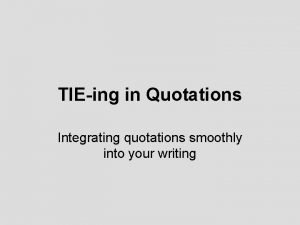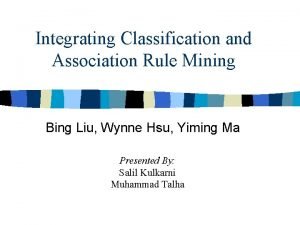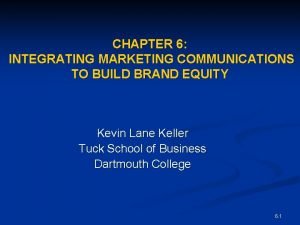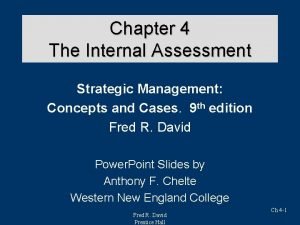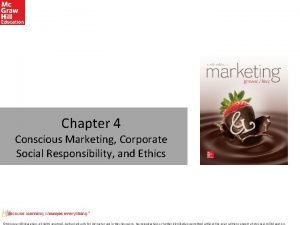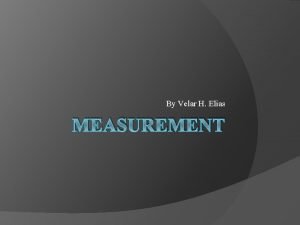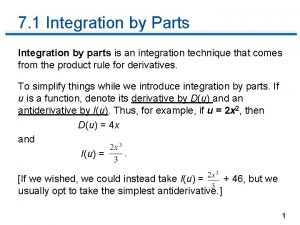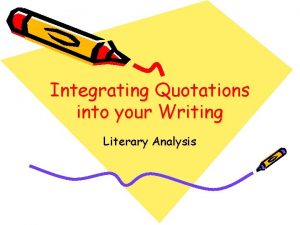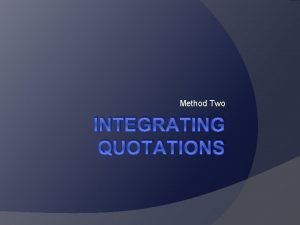Integrating Quotations from a Literary Text into a

















- Slides: 17

Integrating Quotations from a Literary Text into a Literary Analysis Paper GUIDELINES

But why? As you choose quotations for a literary analysis, remember the purpose of quoting. Your paper develops an argument about what the author of the text is doing--how the text "works. “ You use quotations to support this argument; that is, you select, present, and discuss material from the text specifically to "prove" your point—to make your case--in much the same way a lawyer brings evidence before a jury. Quoting for any other purpose is counterproductive. Don't quote to "tell the story" or otherwise convey basic information about the text; assume the reader knows the text. Don't quote just for the sake of quoting or just to fill up space. Don't make the reader jump up and shout "Irrelevant!"

Example: We learn about Mrs. Ramsey's personality by observing her feelings about other characters. For example, Mrs. Ramsey has mixed feelings toward Mr. Tansley, but her feelings seem to grow more positive over time as she comes to know him better. At first Mrs. Ramsey finds Mr. Tansley annoying, as shown especially when he mentions that no one is going to the lighthouse (52). But rather than hating him, at this point she feels pity: "she pitied men always as if they lacked something. . . " (85). Then later, during the gathering, pity turns to empathy as she realizes that Mr. Tansley must feel inferior. He must know, Mrs. Ramsey thinks, that "no woman would look at him with Paul Rayley in the room" (106). Finally, by the end of the dinner scene, she feels some attraction to Mr. Tansley and also a new respect: "She liked his laugh. . She liked his awkwardness. There was a lot in that man after all" (110). In observing this evolution in her attitude, we learn more about Mrs. Ramsey than we do about Mr. Tansley. The change in Mrs. Ramsey's attitude is not used by Woolf to show that Mrs. Ramsey is fickle or confused; rather it is used to show her capacity for understanding both the frailty and complexity of human beings. This is a central characteristic of Mrs. Ramsey's personality.

The contents of a literary analysis Notice that the previous paragraph includes three basic kinds of materials: (a) statements expressing the student's own ideas about the relationship Woolf is creating; (b) data or evidence from the text in summarized, paraphrased, and quoted form; and (c) discussion of how the data support the writer's interpretation. The quotations are used in accordance with the writer's purpose, i. e. to show the development of Mrs. Ramsey's feelings indicates something about her personality.

Quoting vs. the alternatives Quoting is only one of several ways to present textual material as evidence. • You can also refer to events, summarize, and paraphrase. • You will often want merely to refer or point to passages (as in the third sentence above) that contribute to your argument. • In other cases you will want to paraphrase, i. e. "translate" the original into your own words, again instead of quoting. • Summarize or paraphrase when it is not so much the language of the text that justifies your position, but the substance or content.

Quoting selectively Similarly, after you have decided that you do want to use material in quoted form, quote only the portions of the text specifically relevant to your point. Think of the text in terms of units-- words, phrases, sentences, and groups of sentences (paragraphs, stanzas)--and use only the units you need. If it is particular words or phrases that "prove" your point, you do not need to quote the sentences they appear in; rather, incorporate the words and phrases into sentences expressing your own ideas.

Patterns for Incorporating Quotations into Sentences An introducing phrase or contextual bit of info, plus the quotation: 1. In this poem it is creation, not a hypothetical creator, that is supremely awesome. The speaker asks, "What immortal hand or eye / Dare frame thy fearful symmetry? " 2. Gatsby is not to be regarded as a personal failure. "Gatsby turned out all right at the end" (176), according to Nick. 3. "I know you blame me, " Mrs. Compson tells Jason (47). Is she expressing her own sense of guilt?

An assertion of your own and a colon plus the quotation 1. Vivian hates the knights for scorning her, and she dreams of achieving glory by destroying Merlin's: "I have made his glory mine" (390). 2. Fitzgerald gives Nick a muted tribute to the hero: "Gatsby turned out all right at the end" (176). 3. Cassio represents not only a political but also a personal threat to Iago: "He hath a daily beauty in his life / That makes me ugly. . . " (5. 1. 19 -20).

An assertion of your own with quoted material worked in 1. For Nick, who remarks that Gatsby "turned out all right" (176), the hero deserves respect but perhaps does not inspire great admiration. 2. Satan's motion is many things; he "rides" through the air (63), "rattles" (65), and later explodes, "wanders and hovers" like a fire (293). 3. Even according to Cleopatra, Mark Antony's "duty" is to the Roman state.

Punctuation of quotations Commas and periods go inside the closing quotation marks; the other punctuation marks go outside. 1. Lawrence insisted that books "are not life"; however, he wrote exultantly about the power of the novel. 2. Why does Lawrence need to point out that "Books are not life"?

Example Paragraphs Through the use of characterization, readers are given insights into how the racism rife in Maycomb leads to the destruction of innocence and the truth. The character of Atticus Finch is presented as a man of morality and truth and represents the consequences of going against the crowd. For example, after Atticus takes on the trial of Tom Robinson he and his children suffer from the townsfolk’s open disgust at his decision and are called “nigger lovers”. Scout then asks Atticus whether he really is a “nigger lover”, he says “I certainly am. I do my best to love everybody” (p. 120). Although this quote is simple it positions readers to understand his character as one who stands by the truth and his morals no matter what others may think of him. His character contrasts the majority of the Maycomb residents who represent theme of prejudice in this novel. Another extract that relates to Harper Lee’s message about prejudice is from one of Atticus’s speeches at the trial addressing the witnesses for Tom Robinson’s case “the evil assumption – that all Negroes lie, that all Negroes are basically immoral beings, that all Negro men are not to be trusted around our woman, an assumption one associates with the minds of their caliber” (p. 225). This is a powerful speech and would have rung true to almost everyone in the courtroom. To say that it is an ‘evil’ assumption truly shows how strongly Atticus feels about this. This quote addresses what the whole novel is about and positions readers to see the prejudice that was present towns like Maycomb during this time. Atticus’s son Jem Finch has been raised the right way and to be share the same morals as Atticus. The quote “His face was streaked with angry tears as we made our way through the cheerful crowd” (p. 234) is referring to Jem after he discovered that his father lost the case. We can gather from this that Jem was one of the few people mourning for Tom Robinson who the entire town knew deep down was innocent. This quote is powerful as it subtly tells readers that in times like these only the children are weeping and this brings us back to theme of innocence. Here Maycomb’s racism and prejudice has caused an innocent child to weep and has also potentially destroyed that innocence. Harper Lee’s use of characterization effectively conveys her message of prejudice; she also positions readers to understand this message through her description of settings.

Through the use of characterization, readers are given insights into how the racism rife in Maycomb is a dangerous threat to truth and justice. Throughout the novel t he character of Atticus Finch progresses, and as a result of his development, he is viewed as a symbol of all that is morally right. For example, during Tom Robinson’s trial, Atticus speaks about how “all men are created equal” (Page 116) and he outlines the fact that the racism in Maycomb was unjust and unfair for those who are hurt by that verbal abuse. This quote positions the reader to regard the bigotry and injustices that occurred daily in 1930’s Alabama as a basis for the discrimination endured by the Negro community in the novel. The extract “you never really understand someone… until you climb into his skin and walk around in it. ” (Page 33) is taken from when Atticus is teaching Scout about empathy and understanding of others. This is one of the significant morals taught through this novel, and it also portrays Atticus as accepting and perceptive, qualities that many in Maycomb do not possess. Atticus is characterized as a considerate man who follows laws, written and unwritten, and stands up against the prejudice and racism that arises in the small town of Maycomb. Another example of the prejudice present in Maycomb is created through the characterization of Bob Ewell. The reader is positioned to consider him as ‘white trash’, a racists and narrow-minded man living at the bottom of the social hierarchy. When accusing Tom Robinson, an innocent Negro man, of raping his daughter Mayella, Bob says “I seen that black nigger yonder ruttin’ on my Mayella!”. (Page 190) This example of Bob’s predisposed and derogatory accusation demonstrates his discriminatory views on the African-American community of Maycomb. As a result of characterisation of individuals such as Atticus Finch and Bob Ewell, the reader is positioned to view the actions against minorities in Maycomb as a development of the main message regarding prejudice and innocence.

Semi-colons ; Semicolons help you connect closely related ideas when a style mark stronger than a comma is needed. By using semicolons effectively, you can make your writing sound more sophisticated. Connect closely related ideas Link two independent clauses to connect closely related ideas. Some people write with a word processor; others write with a pen or pencil. Link clauses connected by conjunctive adverbs or transitional phrases to connect closely related ideas. But however they choose to write, people are allowed to make their own decisions; as a result, many people swear by their writing methods. Link lists where the items contain commas to avoid confusion between list items There are basically two ways to write: with a pen or pencil, which is inexpensive and easily accessible; or by computer and printer, which is more expensive but quick and neat. Link lengthy clauses or clauses with commas to avoid confusion between clauses Some people write with a word processor, typewriter, or a computer; but others, for different reasons, choose to write with a pen or pencil.

Avoid using a comma when a semicolon is needed: Incorrect: The cow is brown, it is also old. Correct: The cow is brown; it is also old. What's going on here? Both parts of the sentence are independent clauses, and commas should not be used to connect independent clauses if there is no coordinating conjunction. This mistake is known as a comma splice, or run on sentence.

Colons Rule 1. Use a colon to introduce a series of items. Do not capitalize the first item after the colon (unless it's a proper noun). Examples: You may be required to bring many things: sleeping bags, pans, utensils, and warm clothing. I want the following items: butter, sugar, and flour. I need an assistant who can do the following: input data, write reports, and complete tax forms.

Rule 2. A colon instead of a semicolon may be used between independent clauses when the second sentence explains, illustrates, paraphrases, or expands on the first sentence. Example: He got what he worked for: he really earned that promotion. If a complete sentence follows a colon, as in the previous example, it is up to the writer to decide whether to capitalize the first word. Capitalizing a sentence after a colon is generally a judgment call; if what follows a colon is closely related to what precedes it, there is no need for a capital. Note: A capital letter generally does not introduce a simple phrase following a colon. Example: He got what he worked for: a promotion.

Rule 3. A colon may be used to introduce a long quotation. Some style manuals say to indent onehalf inch on both the left and right margins; others say to indent only on the left margin. Quotation marks are not used. Example: The author of Touched, Jane Straus, wrote in the first chapter: Georgia went back to her bed and stared at the intricate patterns of burned moth wings in the translucent glass of the overhead light. Her father was in "hyper mode" again where nothing could calm him down.
 Blending quotations
Blending quotations Making connections
Making connections Quote integration examples
Quote integration examples Paragraph
Paragraph Embedded quotes mla examples
Embedded quotes mla examples Lateral ventricle anatomy
Lateral ventricle anatomy Integrating factor method
Integrating factor method Integrating classification and association rule mining
Integrating classification and association rule mining Bluestar plm dynamics
Bluestar plm dynamics Basic concepts on integrating technology in instruction
Basic concepts on integrating technology in instruction Integrating factor formula
Integrating factor formula Integrating marketing communication to build brand equity
Integrating marketing communication to build brand equity A firm's strengths that cannot be easily matched
A firm's strengths that cannot be easily matched When integrating conscious marketing
When integrating conscious marketing Integrating factor exact equations
Integrating factor exact equations Integrating type dvm
Integrating type dvm Integration by parts meaning
Integration by parts meaning Coming together stage
Coming together stage




